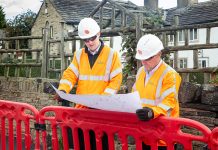Anglian Water has become one of the first water companies in the UK to trial thermal imaging technology to detect leaking water pipes. With nearly 24,000 miles of water pipe to keep an eye on, much of it in rural and remote areas the aerial technology will help reduce the cost and time taken to find a leak by pinpointing its location more precisely.
The drones are just the latest weapon in Anglian Water’s £60million war on leakage. Alongside a 300-strong leakage team, new highly skilled leak detection teams have been tasked with uncovering hard-to-find leaks and have been given specialist training on how to use the new drone technology.
Anglian Water’s approach to water pipe monitoring and tackling leakage has made it an industry leader. Last year the company’s leakage levels were it’s lowest ever – and one of the lowest in the county, at less than half the national average. To keep driving down leakage Anglian Water has to find more and more innovative ways to track down leaks and save water.
The thermal imaging drones work by spotting changes in soil temperature near the water pipes. At this time of year cold mornings are the best time to fly the drone, so that any leaking water is around 10 degrees Celsius warmer than the average ground temperature. They are flown in the morning along the length of the pipe and thermal can be analysed straight away. Any changes in soil temperature are then marked and investigated further by the leakage team.
Chris Utton, Anglian Water’s Intensive Leakage Delivery Manager said: “Once the drone has been flown along the length of the pipeline the image is analysed using industry standard FLIR software. Each image is analysed using the temperature range within the image itself. It can be colour coded for visual aid but generally sit within the greyscale, with white being the hottest and black the coldest.
During the winter trials, freezing fog had been challenging conditions for the drone to fly in. The freezing fog often formed ice crystals on the rotor blades of the drone and caused the batteries to discharge faster than usual. The company also plans to run trials during the summer, when the weather gets warmer. It is hoped the drone will fly during the late afternoon, early evening and will identify cold spots, where water is pooling under the surface of the ground, rather than hotspots.
Another benefit of the drone technology it is helps to minimise disruption for customers, by covering large lengths of the water pipeline in a short space of time. The sensor and camera on the drone can identify differences in soil temperature. These differences are then analysed and the exact point of the temperature change is then investigated using traditional leakage approaches and by excavating the area.
All this means the job can be carried out quicker and more precisely – meaning less digging, less cost to the business, less water lost and less disruption to customers.
Chris added: “Each drone flight that dectects a leak could save the company up to £7,000 in water lost through leakage and can save tens of thousands of pounds if the leak can never be identified using traditional leak detection and the pipe is then replaced. The drones are just one way of helping to keep customers’ bills low.
“So far the trials have helped find and fix leaks on sections of water pipe that had previously been earmarked to be replaced due to their high leakage levels. Being able to find the leak and repair it has resulted in £150,000 CAPEX savings, and a further 0.26ml/d bottom line leakage benefit.
“Although the technology has been the most successful in rural areas, where pipes are laid beneath soil, the thermal imaging drones have also been successful on asphalt. The thermal imaging camera has already identified a leak through an asphalted road, however it’s early days for this technology being used in the water industry and we’re hoping to really understand the range potential of the technology in our next phase of trials.”







